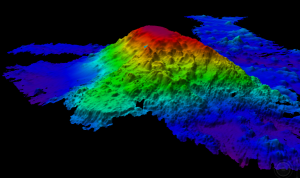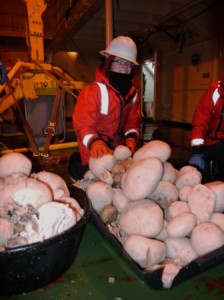
Sars is a quite sizeable seamount in the middle of the Drake Passage (~59.44S, ~68.08W), but why are we so interested in it? Sars is conveniently located in the middle of the Drake Passage, and hence in a spot where we should see changes in major water mass configurations on glacial-interglacial time scales. Finding old corals (e.g., corals with ages between 25,000 years ago and today) at Sars would enable us to obtain direct insights into the Southern Ocean’s role in natural climate change since the last glacial maximum (~20,000 years ago). It also has been reported in the literature that our favourite aragonitic cold water coral , Desmophyllum dianthus, was found on this seamount, and chief scientist Laura Robinson and myself published a paper on a 16,700 years old D.dianthus from Sars Seamount a couple of years ago (Robinson and van de Flierdt, 2009, Geology).
So it’s not too surprising that we put quite some effort into recovering corals and exploring the deep-sea habitat at Sars. What we found was an amazingly rich seafloor fauna and a fantastic looking collection of fossil corals. But the most memorable moment on Sars was when one of our deployments brought up a huge number of enormous sponges (see the picture – they are VERY large!). Sponges occur pretty much in all water depth and make their skeletons from glassy needles, called spicules. With Kate Hendry, we even have a researcher onboard who studies these sponges, and she clearly had one of her most happy days at Sars. For the rest of us the mission was to watch out for those nasty spicules. They really become unpleasant once they slip into your gloves or cold weather gear…
Bye bye Sars – welcome to the Cape Horn!
